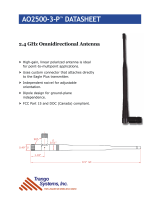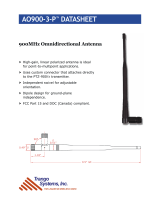Page is loading ...

Antenna Product Portfolio for
Cisco Aironet 802.11n Access Points
At-A-Glance
Cisco
®
Aironet
®
802.11n access points (namely, the 1250 Series, 1260 Series, and
3500e Series) require the use of external antennas to make them fully functioning units.
Although most existing Cisco antennas can be used, Cisco has developed antennas
specifically designed for use with 802.11n access points to optimize performance. This
document explains the antenna options for the Cisco Aironet 802.11n access points.
Flexible Options
Cisco offers a variety of antennas that provide different mounting options and coverage
patterns. Customers can select an antenna that will increase the overall efficiency
and data rates of their wireless network, while accommodating specific deployment
conditions, including physical layout, distance, and aesthetics. To optimize the overall
performance of a Cisco wireless LAN, it is important to understand how to maximize
radio coverage with the appropriate antenna selection and placement. Table 1 illustrates
three antenna types available for use with the 802.11n access points..
Table 1. Antenna Types for Cisco Aironet 802.11n Access Points
Antenna Type Description Ideal Deployment
Omnidirectional
360 degree coverage pattern. Circular
pattern to cover wide areas
Open office areas, hallways, conference
rooms, outside areas
Dipole
360 degree coverage pattern. Circular
pattern covers large areas
Carpeted space environments, classrooms,
hallways, conference rooms.
Directional
Focused signal to direct energy in
certain directions
Hallways, outside areas, on walls pointing
inward to direct signals.
Omnidirectional Antennas
An omnidirectional antenna is designed to provide a 360-degree radiation pattern. This
type of antenna is used when coverage in all directions from the antenna is required.
Cisco provides different types of omnidirectional antennas for use in a variety of
environments, such as retail, manufacturing, or offices. Cisco provides both dipole
antennas and indoor/outdoor omnidirectional antennas.
Dipole Antennas
Dipole antennas provide a large, circular coverage pattern. The antennas are available
in three different colors (white, black and gray) so that they blend better into the area in
which they will be placed. The white and black dipole antennas can be bent in different
angles to modify the coverage as needed. The gray dipole does not offer this option
and is shorter than its counterparts. If a reduced-sized dipole antenna is needed (for
example, in an area where dipoles projecting into the space are undesirable), the gray
dipole should be considered.
Other applications for dipoles include large, open areas like conference rooms or
lecture halls. Areas requiring shared coverage—in which the access point is placed in
the middle of the room or in a hallway, such as in a hotel or medical facility—are also a
good use for the small form-factor dipole. Because of the circular pattern of coverage
provided by dipole antennas, rooms located directly off the hallway may receive
coverage as well. Table 2 lists the part numbers for 2.4-GHz and 5-GHz dipole antennas.
Table 2. Dipole Antennas for Cisco Aironet 802.11n Access Points
2.4-GHz Dipole Antenna Part Numbers Quantity Required Color Gain
AIR-ANT4941,
AIR-ANT2422DB-R*
3 Black 2.2 dBi
AIR-ANT2422DW-R=,
AIR-ANT2422DW-R*
3 White 2.2 dBi
AIR-ANT2422DG-R=,
AIR-ANT2422DG-R*
3 Gray 2.2 dBi
AIR-ANT2422SDW-R=,
AIR-ANT2422SDW-R*
3 White (Short) 2.2 dBi
5-GHz Dipole Antenna Part Numbers Quantity Required Color Gain
AIR-ANT5135D-R,
AIR-ANT5135DB-R*
3 Black 3.5 dBi
AIR-ANT5135DW-R=,
AIR-ANT5135DW-R*
3 White 3.5 dBi
© 2010 Cisco and/or its affiliates. All rights reserved. Cisco, the Cisco logo, and Cisco Systems are registered trademarks or trademarks of Cisco and/or its affiliates in the United States and certain other countries. All other trademarks mentioned in this document or Website are the
property of their respective owners. The use of the word partner does not imply a partnership relationship between Cisco and any other company. (1005R)

Antenna Product Portfolio for
Cisco Aironet 802.11n Access Points
At-A-Glance
5-GHz Dipole Antenna Part Numbers Quantity Required Color Gain
AIR-ANT5135DG-R=,
AIR-ANT5135DG-R*
3 Gray 3.5 dBi
AIR-ANT5135SDW-R=,
AIR-ANT5135SDW-R*
3 White (Short) 3.5 dBi
*Available as Configuration Option when ordering Access Point
Indoor/Outdoor Omnidirectional Antennas
Omnidirectional antennas are connected to the access point via short, attached cables.
The antennas can be mounted to a ceiling and provide a large, circular coverage area.
These antennas can be used both indoors and outdoors (see Table 3 for specific details
for usage) and are typically mounted on a ceiling or mast-pole. Examples of places in
which omnidirectional antennas are useful include warehouses, manufacturing floors,
and other large areas, as well as outdoor seating areas, such as cafés or central gather-
ing places for students. Omnidirectional antennas can also be used to provide good
coverage in a retail environment, both inside and outside, as well as in areas where
trucks or police cars park to upload data..
Table 3. Indoor/Outdoor Omnidirectional Antennas for Cisco Aironet 802.11n Access Points
2.4-GHz Omnidirectional
Antenna Part Numbers Quantity Required Description Gain
AIR-ANT1728 3 Ceiling-mount:
indoor/outdoor
5.2 dBi
AIR-ANT2506 3 Mast-mount: indoor/
outdoor
5.2 dBi
AIR-ANT2430V-R= 1 Ceiling-mount:
indoor
3 dBi
5-GHz Omnidirectional
Antenna Part Numbers Quantity Required Description Gain
AIR-ANT5160V-R 3 Ceiling-mount:
indoor/outdoor
6 dBi
AIR-ANT5140V-R= 1 Ceiling-mount:
indoor
4 dBi
2.4 and 5-GHz
Omnidirectional Antenna Quantity Required Description Gain
AIR-ANT2451NV-R= 1 Ceiling-mount:
indoor
2.5 dBi (2.4
GHz)
3.5 dBi (5
GHz)
Directional Antennas
Directional antennas redirect the signal they receive from the access point. Redirecting
the signal has the effect of providing more energy in one direction and less energy in
all other directions.
Patch and Yagi Antennas
These antennas are typically mounted to a wall or a mast and provide coverage in a
limited-angle pattern. Application cases for a directional antenna include RF coverage
down a hallway in a hospital or office corridor. In a warehouse or manufacturing facility,
which typically have high steelshelving units, aiming a directional antenna down open
areas provides coverage for people moving among the shelves with their wireless
devices. The mining industry also benefits from the use of directional antennas when
wireless is used in the shafts. Table 4 shows the directional antennas available for use
with the Cisco Aironet 802.11n access points.
© 2010 Cisco and/or its affiliates. All rights reserved. Cisco, the Cisco logo, and Cisco Systems are registered trademarks or trademarks of Cisco and/or its affiliates in the United States and certain other countries. All other trademarks mentioned in this document or Website are the
property of their respective owners. The use of the word partner does not imply a partnership relationship between Cisco and any other company. (1005R)

Antenna Product Portfolio for
Cisco Aironet 802.11n Access Points
At-A-Glance
Table 4. Directional Antennas for Cisco Aironet 802.11n Access Points
2.4-GHz Directional Antenna Part Numbers
Quantity
Required Description Gain
AIR-ANT2460NP-R 1 Patch antenna: indoor/
outdoor, wall mount
6 dBi
AIR-ANT2485P-R* 3 Patch antenna: indoor/
outdoor, wall mount
8.5 dBi
AIR-ANT2410Y-R* 3 Yagi antenna: indoor/
outdoor, mast mount
10 dBi
*Not approved for use with 1260 Series and 3500e Series (must be 6 dBi or less)
Why Cisco?
Cisco is committed to providing the best access points, client adapters, and bridges
in the industry and to providing a complete solution for any wireless LAN deployment.
Cisco also has the widest range of antennas, cable, and accessories available from any
wireless manufacturer. For more information on Cisco Aironet antennas, visit:
http://wwwin.cisco.com/ewtg/wnbu/products/antennas.shtml.
© 2010 Cisco and/or its affiliates. All rights reserved. Cisco, the Cisco logo, and Cisco Systems are registered trademarks or trademarks of Cisco and/or its affiliates in the United States and certain other countries. All other trademarks mentioned in this document or Website are the
property of their respective owners. The use of the word partner does not imply a partnership relationship between Cisco and any other company. (1005R) C45-513837-02 08/10
/

